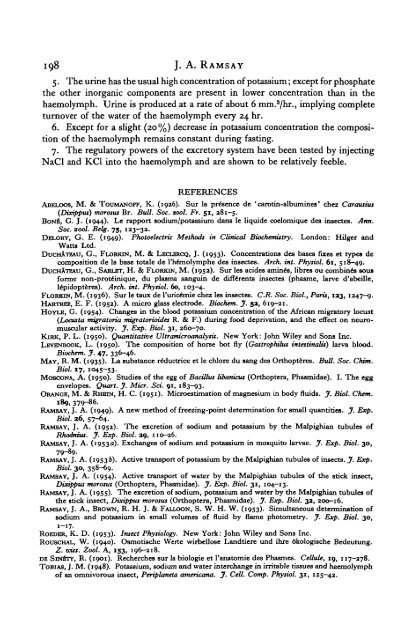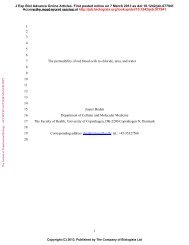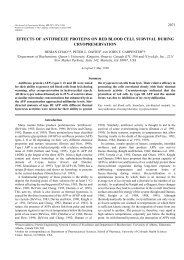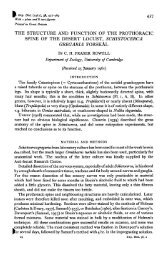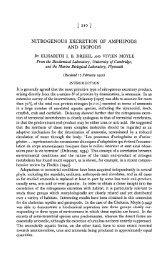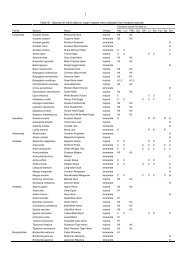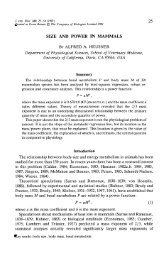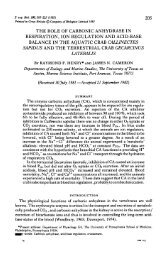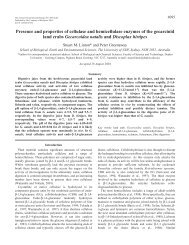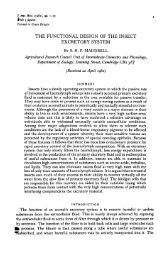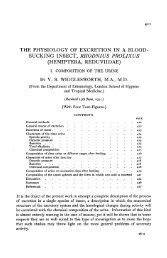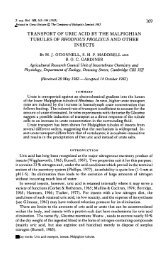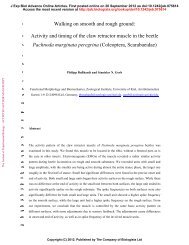the excretory system of the stick insect, dixippus morosus
the excretory system of the stick insect, dixippus morosus
the excretory system of the stick insect, dixippus morosus
Create successful ePaper yourself
Turn your PDF publications into a flip-book with our unique Google optimized e-Paper software.
198 J. A. RAMSAY<br />
5. The urine has <strong>the</strong> usual high concentration <strong>of</strong> potassium; except for phosphate<br />
<strong>the</strong> o<strong>the</strong>r inorganic components are present in lower concentration than in <strong>the</strong><br />
haemolymph. Urine is produced at a rate <strong>of</strong> about 6 mm. 3 /hr., implying complete<br />
turnover <strong>of</strong> <strong>the</strong> water <strong>of</strong> <strong>the</strong> haemolymph every 24 hr.<br />
6. Except for a slight (20%) decrease in potassium concentration <strong>the</strong> composition<br />
<strong>of</strong> <strong>the</strong> haemolymph remains constant during fasting.<br />
7. The regulatory powers <strong>of</strong> <strong>the</strong> <strong>excretory</strong> <strong>system</strong> have been tested by injecting<br />
NaCl and KC1 into <strong>the</strong> haemolymph and are shown to be relatively feeble.<br />
REFERENCES<br />
ABELOOS, M. & TOUMANOFF, K. (1926). Sur la presence de ' carotin-albumines' chez Carausius<br />
(Dixippus) <strong>morosus</strong> Br. Bull. Soc. zool. Fr. 51, 281-5.<br />
BONE, G. J. (1944). Le rapport sodium/potassium dans le liquide coelomique des <strong>insect</strong>es. Aim.<br />
Soc. zool. Belg. 75, 123-32.<br />
DELORY, G. E. (1949). Photoelectric Methods in Clinical Biochemistry. London: Hilger and<br />
Watts Ltd.<br />
DUCHATEAU, G., FLORKTN, M. & LECLERCQ, J. (1953). Concentrations des bases fixes et types de<br />
composition de la base totale de l'hernolymphe des <strong>insect</strong>es. Arch. int. Physiol. 61, 518-49.<br />
DUCHATEAU, G., SABLBT, H. & FLORKIN, M. (1952). Sur les acides amines, Iibres ou combines sous<br />
forme non-prot6inique, du plasma sanguin de diffcrents <strong>insect</strong>es (phasme, larve d'abeille,<br />
lepidopteres). Arch. int. Physiol. 60, 103-4.<br />
FLORKIN, M. (1936). Sur le taux de l'uricemie chez les <strong>insect</strong>es. CJi. Soc. Biol., Paris, 133, 1247-9.<br />
HABTREE, E. F. (1952). A micro glass electrode. Biochem. J. 53, 619-21.<br />
HOYLB, G. (1954). Changes in <strong>the</strong> blood potassium concentration <strong>of</strong> <strong>the</strong> African migratory locust<br />
(Locusta migratoria migratorioides R. & F.) during food deprivation, and <strong>the</strong> effect on neuromuscular<br />
activity. J. Exp. Biol. 31, 260-70.<br />
KIRK, P. L. (1950). Quantitative Ultramtcroanalysis. New York: John Wiley and Sons Inc.<br />
LBVENBOOK, L. (1950). The composition <strong>of</strong> horse bot fly (Gastrophihis intestinalis) larva blood.<br />
Biochem. J. 47, 336-46.<br />
MAY, R. M. (1935). La substance r^ductrice et le chlore du sang des Orthopteres. Bull. Soc. Ckim.<br />
Biol. 17, 1045-53.<br />
MOSCONA, A. (1950). Studies <strong>of</strong> <strong>the</strong> egg <strong>of</strong> Bacillus Ubanicus (Orthoptera, Phasmidae). I. The egg<br />
envelopes. Quart. J. Micr. Set. 91, 183-93.<br />
ORANGE, M. & RHKIN, H. C. (1951). Microestimation <strong>of</strong> magnesium in body fluids. J. Biol. Chem.<br />
189, 379-86.<br />
RAMSAY, J. A. (1949). A new method <strong>of</strong> freezing-point determination for small quantities. J. Exp.<br />
Biol. 26, 57-^64.<br />
RAMSAY, J. A. (1952). The excretion <strong>of</strong> sodium and potassium by <strong>the</strong> Malpighian tubules <strong>of</strong><br />
Rhodmus. J. Exp. Biol. 39, 110-26.<br />
RAMSAY, J. A. (1953a). Exchanges <strong>of</strong> sodium and potassium in mosquito larvae. J. Exp. Biol. 30,<br />
79-89.<br />
RAMSAY, J. A. (19536). Active transport <strong>of</strong> potassium by <strong>the</strong> Malpighian tubules <strong>of</strong> <strong>insect</strong>s. J. Exp.<br />
Biol. 30, 358-69.<br />
RAMSAY, J. A. (1954). Active transport <strong>of</strong> water by <strong>the</strong> Malpighian tubules <strong>of</strong> <strong>the</strong> <strong>stick</strong> <strong>insect</strong>,<br />
Dixippus <strong>morosus</strong> (Orthoptera, Phasmidae). J. Exp. Biol. 31, 104-13.<br />
RAMSAY, J. A. (1955). The excretion <strong>of</strong> sodium, potassium and water by <strong>the</strong> Malpighian tubules <strong>of</strong><br />
<strong>the</strong> <strong>stick</strong> <strong>insect</strong>, Dixippus <strong>morosus</strong> (Orthoptera, Phasmidae). J. Exp. Biol. 33, 200-16.<br />
RAMSAY, J. A., BROWN, R. H. J. & FALLOON, S. W. H. W. (1953). Simultaneous determination <strong>of</strong><br />
sodium and potassium in small volumes <strong>of</strong> fluid by flame photometry. J. Exp. Biol. 30,<br />
1-17.<br />
ROEDER, K. D. (1953). Insect Physiology. New York: John Wiley and Sons Inc.<br />
ROUSCHAL, W. (1940). Osmotische Werte wirbellose Landtiere und ihre 6kologische Bedeutung.<br />
Z. miss. Zool. A, 153, 196-218.<br />
DE SINETY, R. (1901). Recherches sur la biologie et ranatomie des Phasmes. Cellule, 19, 117-278.<br />
TOBIAS, J. M. (1948). Potassium, sodium and water interchange in irritable tissues and haemolymph<br />
<strong>of</strong> an omnivorous <strong>insect</strong>, Periplaneta americana. J. Cell. Camp. Physiol. 31, 125-42.


